
Salt and Fire
I don’t normally do movie reviews on my blog because there are so many movies and so many reviews already. But Salt and Fire, the latest Werner Herzog movie, is deserving of my attention because it is almost universally despised. Only twenty-five percent at Rotten Tomatoes, and only four stars at IMDB, and reviews like “Easily the worst movie Herzog has ever made.”
I disagree. It’s a terrific movie and I’ll try to explain why. I went to it because I love Herzog and I’m a fan of Michael Shannon (See him in “My Son, My Son…” (a Herzog movie) and in “Ice Man” and in “99 Homes.” ) I didn’t know Veronica Ferres, a mega-star in Germany.
The main complaint against Salt and Fire is that it has essentially “no” story, poor script, stiff acting, and its images are unimpressive. But that’s all misleading, perhaps deliberately so. I think it’s a philosophical essay on the theme of “perceptual distortion.”
I can’t quite put it all together, but if I were going to, here are the elements I would focus on.
- The story line was so weak as to be almost non-existent. The dialog was stilted, the script chaotic and the acting alternately wooden and overdone. Action was ludicrous and plot development implausible. The slight ecology theme was perfunctory. Even the locations and sets were implausible (e.g., hasty new paint on a run-down hotel). Sounds great? Well, none of that was accidental.
The message is: Don’t look here for traditional storytelling. Your idea of a movie as a drama played out on a stage does not apply. The whole methodology of storytelling is actually a cultural syntax and not a natural mode of communication. It is a distortion, and this movie will distort that traditional mode to illustrate the distortion.
- Visual distortion is the main theme. Movies especially are a learned syntax for perceiving. You normally accept a movie as a window on a reality rather than the artificial construction that it is. Twenty-four pictures per second become a moving image only because of a perceptual illusion but you don’t even think about that. You accept the movie in the natural attitude.
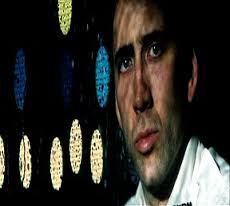
Anamorphic compression
Movies as managed distortion is seen in the anamorphic lens, an oval or cylindrical vertical element in the camera that compresses the image on the horizontal axis.
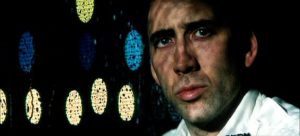
Uncompressed Pic
The projector then has a “reverse” lens that re-stretches the image back to normal size for viewing.
The process is widely used and was used in Salt and Fire.
Anamorphic photography is used is to enhance image density and saturation but especially to capture wide-screen shots with good detail. I believe this is why the movie was shot on the salt flats in the first place. It is about as wide-open a location as you could imagine, with hardly any detail. It is pure wide-openness. I’ll bet Herzog’s thinking went from the anamorphic lens to that particular location, not the reverse.
Other visual, photographic tricks were shown throughout the movie to clue the viewer into this theme – hey, it’s anamorphosis over here! Herzog practically hit us over the head with it.
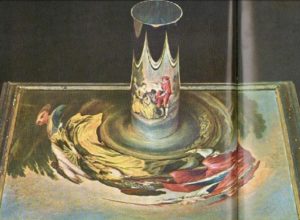
Mirror anamorphosis
We also saw a big demo of mirror anamorphosis, described by Shannon’s character. The theme was repeated again at Shannon’s description and flashback of the anamorphic painting in Rome, a tradition in art since the Renaissance.
So we get the message: pictures, especially in movies, are not “real.” We tend to view them as mere windows on reality but what they show depends entirely on your point of view.
- The photography very much emphasized close-ups of the
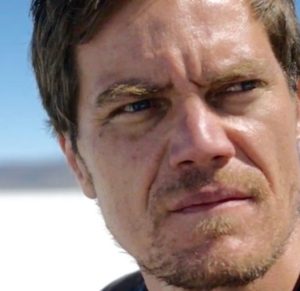 actors’ faces – extreme close ups, often from forehead to chin, and those pictures were held for up to fifteen seconds. That’s unusual and it was very frequent in the film. Why did Herzog do it?
actors’ faces – extreme close ups, often from forehead to chin, and those pictures were held for up to fifteen seconds. That’s unusual and it was very frequent in the film. Why did Herzog do it?
Traditionally, that’s how you show that a character is thinking, and often Herzog had a voiceover to give the thoughts during the closeup. But that doesn’t fully explain what was going on.
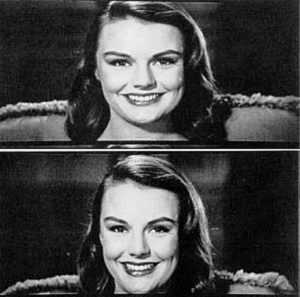
Anamorphic mumps
One additional explanation is that the closeups illustrate “anamorphic mumps,” a distortion inherent to the anamorphic lens which broadens the face unnaturally in over-correction and makes the actor look like they have mumps. This distortion can be mostly corrected in post-production. A. mumps are especially prominent and hard to correct when the face is off-center on the screen. I’d have to see the movie again to decide if most of the facial closeups were off center. I can’t remember. In any case, Even though A. mumps were not obvious in the film, the facial closeups may have been another reminder about anamorphosis in visual perception.
Another aspect of the extreme closeups is the idea that faces themselves are distortions. You can’t tell by looking at somebody what they’re thinking. And in the movie, the voice-over thoughts delivered during the closeups were often extremely banal. I don’t know exactly why. Something to do with the person within versus the public persona – especially emphasized in the highly distinctive faces of these particular actors, the leads, but also in the boys.
- There was a strong memento mori theme, the idea that people should be reminded that life is short and we’re all mortal. Several of the banal pseudo-philosophical quotations given by Shannon’s character were of this nature, and carefully repeated just to be sure we got them.
What was that about? It may be related to the supposed ecological disaster and the volcano threat – “Don’t forget, people, we’re all gonna die!”
Herzog may have been trying to tie the theme of distortion to our everyday perception of life. You think your everyday life is important, but don’t forget: memento mori! You have the rumbling eruption “heard” just underfoot as a powerful reminder.
The superficial story line also reinforces this view. You think you’re going on a routine scientific expedition and you’re suddenly in jail and then in a life-threatening situation. Memento mori! Life itself is an illusory distortion.
I cannot right now add up all these elements into a coherent whole, but I do believe the film was a didactic presentation (as Herzog films tend to be), concerning the topic of perception as distortion. It was not supposed to be, and it wasn’t, traditional storytelling.
The interesting thing is that he didn’t do any overt, obvious distortion in the photography, which would have been very easy. Instead, his message was subtle but clear, as if to show both the distortion and how readily we overlook it.
I need to think further about the idea that storytelling, as we know it, is a fraud. But it was a great, thought-provoking, and satisfying movie
And that’s my story.

I am sorry that you failed to see the true meaning of the film it is deeper than you can understand but that is ok when you are older you will remember this (one day you will say holy crap that is what he meant and think back to little old me and say dam that guy was right lol open your mind my friend we are so used to the garbage Hollywood has let get put out and that other sources are putting out that we have lost to value of looking at a film in more than one way kinda an anamorphic way if you will 😉